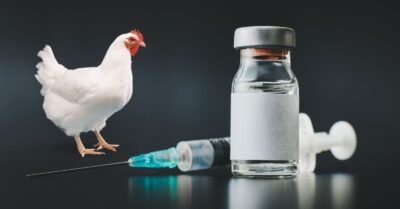Why are Marek’s viruses are used in recombinant vaccine?

Dr. Melad Ibrahim Urabi / Poultry Diseases pathologist
12-16-2024
When scientists fear that they will reach the emergence of a complete adolescent from infection with the disease, the enemy takes the important part of this virus and loads it on another virus, so that its genome is large, and some amino acids can be deleted from it without affecting the new virus (success) in its work and reproduction, and in vital matters. Therefore, scientists succeeded in obtaining the Marek’s virus with this advanced technology in transferring and loading some viruses from other viruses, which is called the effects of recombinant vaccine.
The advantages of these methods are:
- Provides broad immune protection and stimulates cellular and humoral immune response.
- Herpes virus has a specific characteristic, especially (HVT) where it overcomes the interference caused by maternal immunity (MDA) coming from the mother.
- These vaccines do not cause negative reactions to the bird, and their risk is very slight, or almost non-existent in returning again to virulence and genetic stability.
- These vaccines have a very weak potential in the process of horizontal transmission between birds.
- They can be given very simply under the skin at the age of one day or in the egg.
There are 3 carcinogenic strains of Marek’s disease virus (MDV 1.2.3) and the strain (MDV3) isolated from turkeys and called (HVT) is considered non-carcinogenic and is considered a carrier of other virus genes. It has an important advantage, which is its ability to circumvent maternal antibodies and continuous stimulation of infection to obtain long-term immunity. These two reasons are what made the strain (HVT) one of the important viruses in the process of manufacturing recombinant vaccines. Therefore, scientists considered this type of Marek’s virus non-pathogenic in poultry, as it became safer in vaccine manufacturing.
There is a very important note during the manufacture of loaded vaccines, as the more proteins loaded on the (HVT), the less its biological processes of replication, copying, integration or entry. This means that if it is loaded on one protein, it will be different from if it is loaded on more than one protein.

That is, different insertion sites can affect the expression of the added proteins on the HVT strain and thus will affect the type, form and amount of immune protection formed and the proteins loaded on it. Differences in the position of the protein pieces to be loaded can put stress on the Marek’s genome as a whole and thus will affect the formation of different immunity in each assembly.
Conclusion
The use of recombinant vaccines in vaccination operations plays an important role in reducing the incidence of some diseases in which we need only one protein to limit their spread. Using more than one protein to load the HVT virus will lead to a delay in the biological work of this virus and thus we will not get correct results from the vaccination process.



